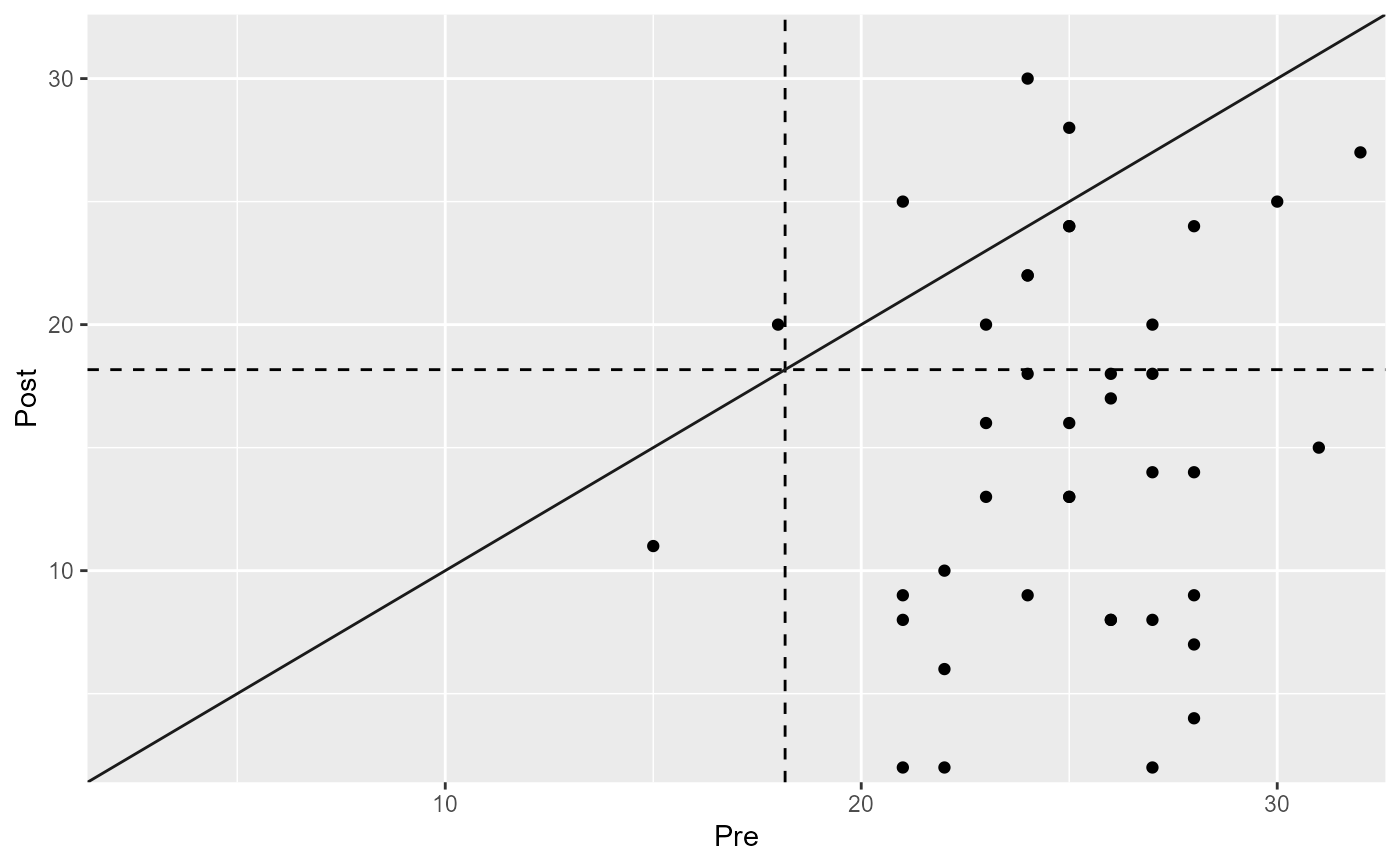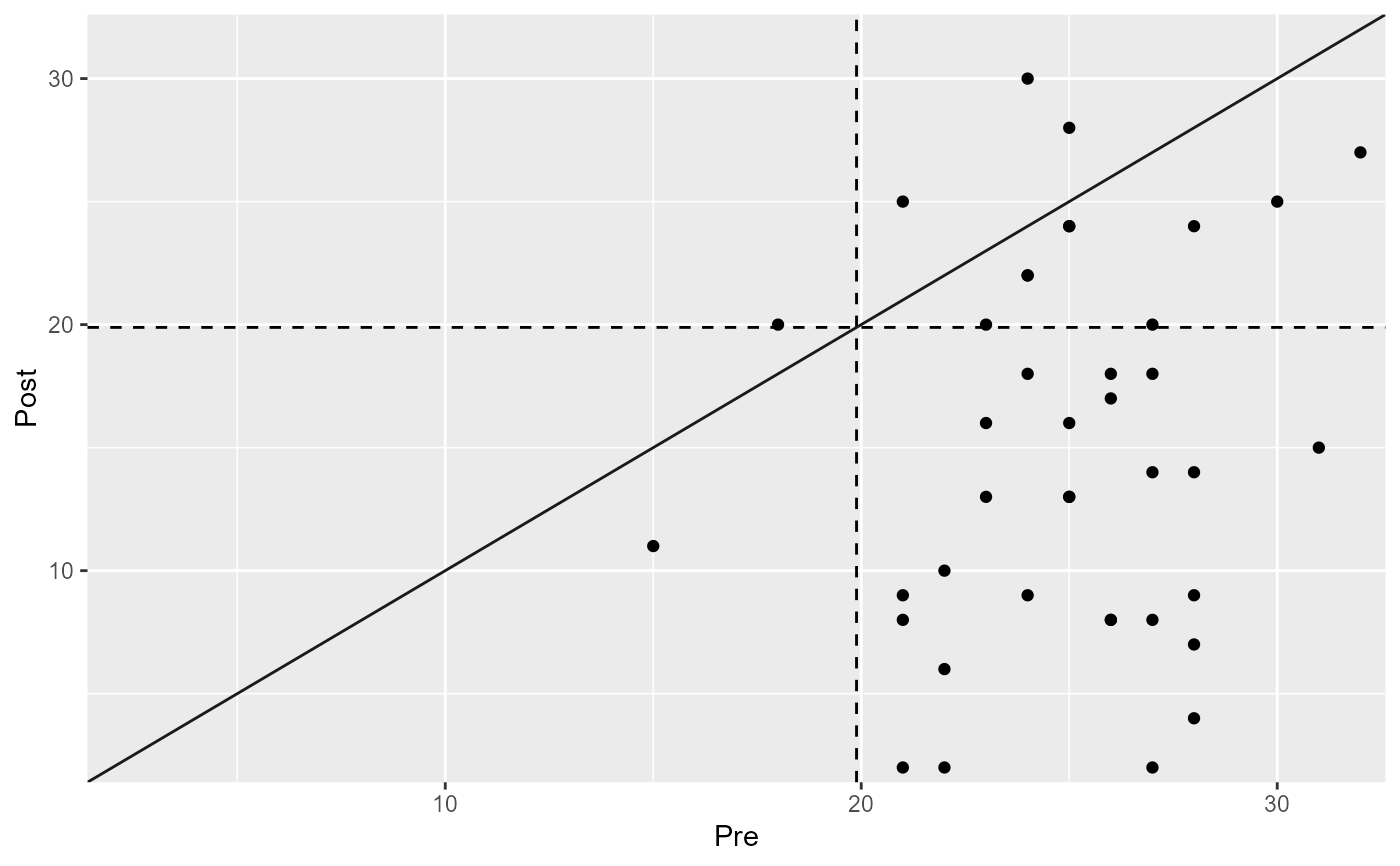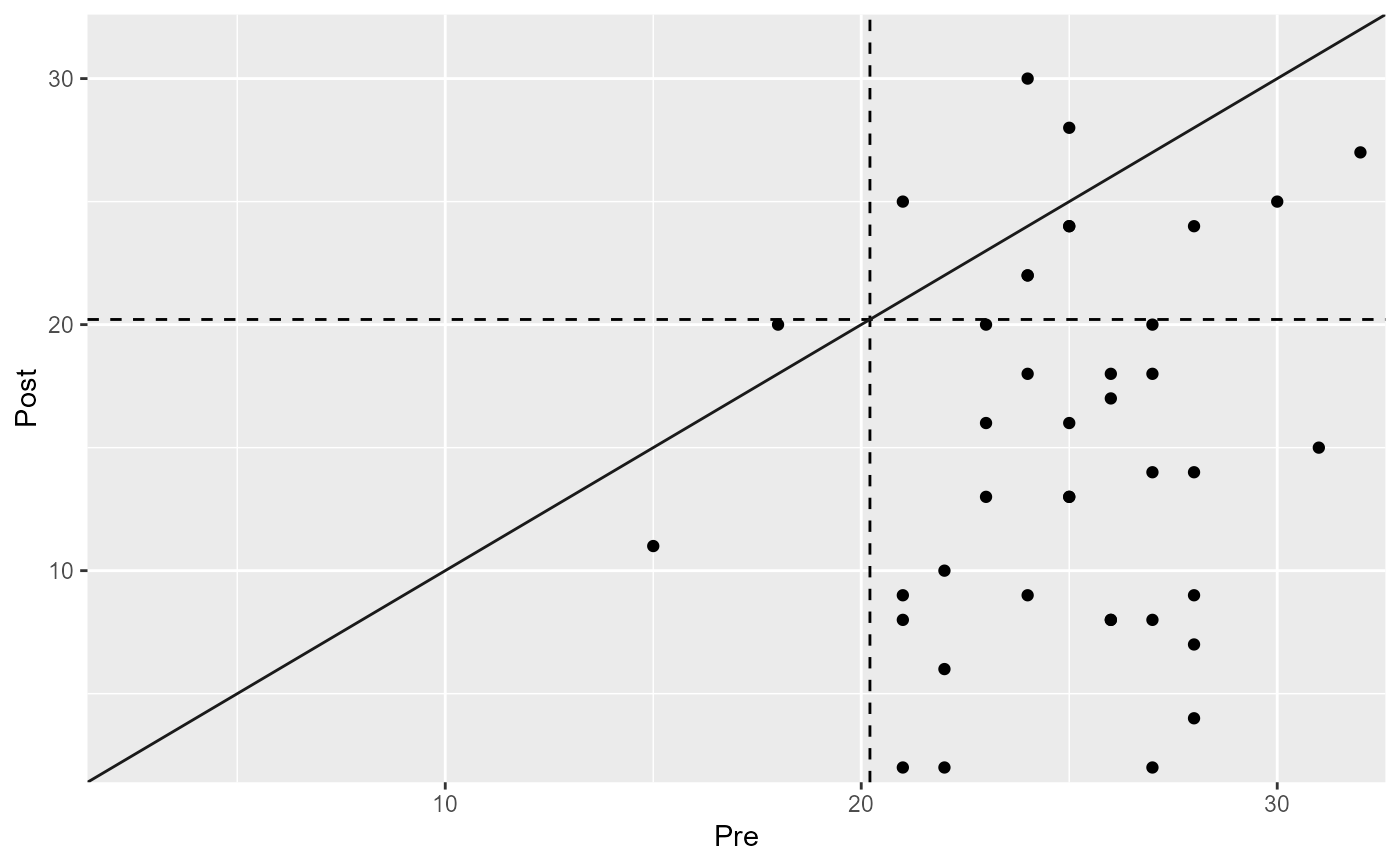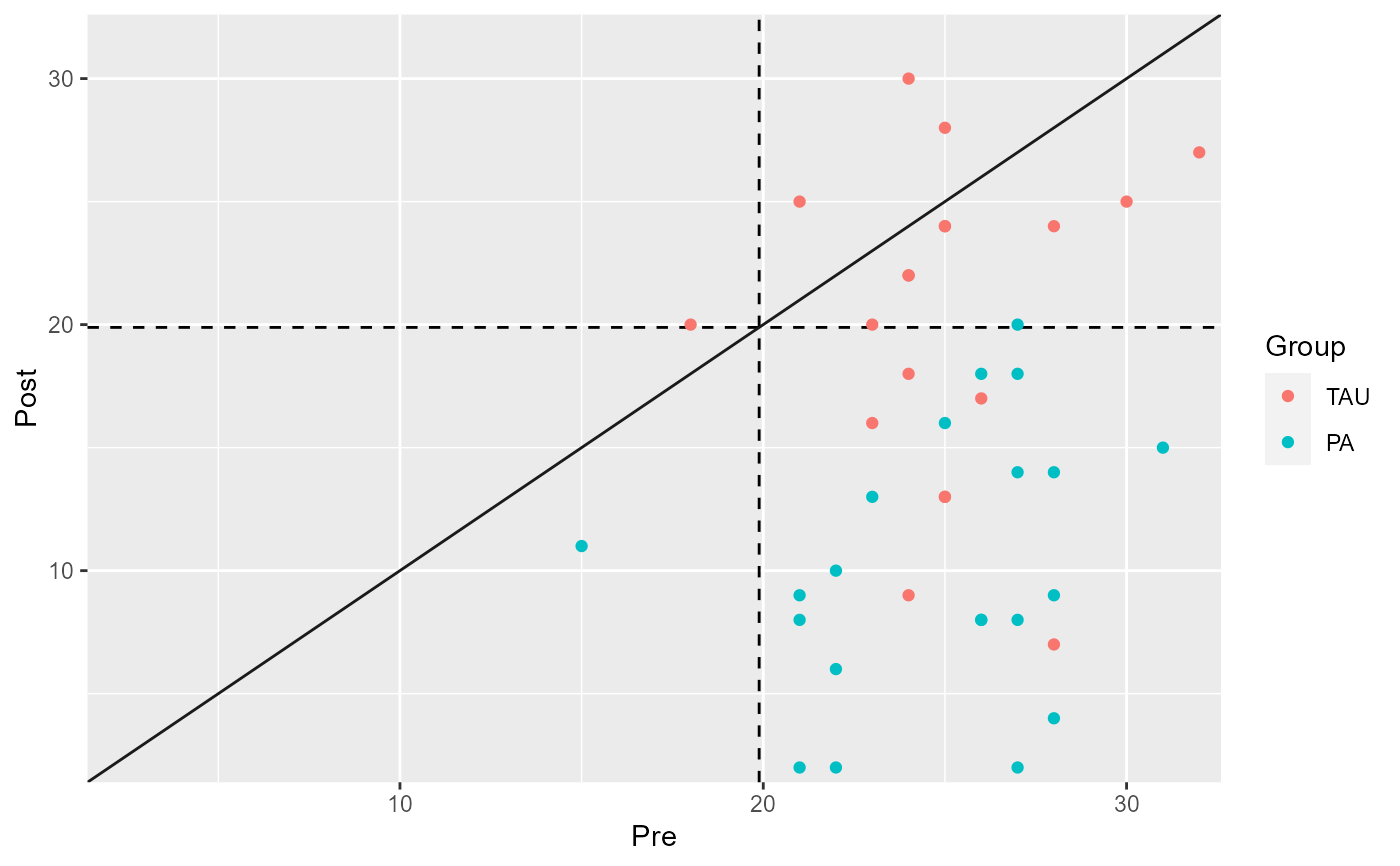cs_statistical() can be used to determine the clinical
significance of intervention studies employing the statistical approach. For
this, it will be assumed that the functional (non-clinical population) and
patient (clinical population) scores form two distinct distributions on a
continuum. cs_statistical() calculates a cutoff point between these two
populations and counts, how many patients changed from the clinical to the
functional population during intervention. Several methods for calculating
this cutoff are available.
Arguments
- data
A tidy data frame
- id
Participant ID
- time
Time variable
- outcome
Outcome variable
- group
Grouping variable (optional)
- pre
Pre measurement (only needed if the time variable contains more than two measurements)
- post
Post measurement (only needed if the time variable contains more than two measurements)
- m_functional
Numeric, mean of functional population.
- sd_functional
Numeric, standard deviation of functional population
- reliability
The instrument's reliability estimate. If you selected the NK method, the here specified reliability will be the instrument's pre measurement reliability. Not needed for the HLM method.
- better_is
Which direction means a better outcome for the used instrument? Available are
"lower"(lower outcome scores are desirable, the default) and"higher"(higher outcome scores are desirable)
- cutoff_method
Cutoff method, Available are
"JT"(Jacobson & Truax, 1991, the default)"HA"(Hageman & Arrindell, 1999)
- cutoff_type
Cutoff type. Available are
"a","b", and"c". Defaults to"a"but"c"is usually recommended. For"b"and"c", summary data from a functional population must be given with argumentsm_functionalandsd_functional.- significance_level
Significance level alpha, defaults to
0.05. If you choose the"HA"method, this value corresponds to the maximum risk of misclassification
Computational details
There are three available cutoff types, namely a, b, and c which can be used to "draw a line" or separate the functional and clinical population on a continuum. a as a cutoff is defined as the mean of the clinical population minus two times the standard deviation (SD) of the clinical population. b is defined as the mean of the functional population plus also two times the SD of the clinical population. This is true for "negative" outcomes, where a lower instrument score is desirable. For "positive" outcomes, where higher scores are beneficial, a is the mean of the clinical population plus 2 \(\cdot\) SD of the clinical population and b is mean of the functional population minus 2 \(\cdot\) SD of the clinical population. The summary statistics for the clinical population are estimated from the provided data at pre measurement.
c is defined as the midpoint between both populations based on their respective mean and SD. In order to calculate b and c, descriptive statistics for the functional population must be provided.
Categories
Individual patients can be categorized into one of the following groups:
Improved, i.e., one changed from the clinical to the functional population
Unchanged, i.e., one can be seen as a member of the same population pre and post intervention
Deteriorated, i.e., one changed from the functional to the clinical population during intervention
Data preparation
The data set must be tidy, which corresponds to a long data frame in general. It must contain a patient identifier which must be unique per patient. Also, a column containing the different measurements and the outcome must be supplied. Each participant-measurement combination must be unique, so for instance, the data must not contain two "After" measurements for the same patient.
Additionally, if the measurement column contains only two values, the first
value based on alphabetical, numerical or factor ordering will be used as
the pre measurement. For instance, if the column contains the
measurements identifiers "pre" and "post" as strings, then "post"
will be sorted before "pre" and thus be used as the "pre" measurement.
The function will throw a warning but generally you may want to explicitly
define the "pre" and "post" measurement with arguments pre and
post. In case of more than two measurement identifiers, you have to
define pre and post manually since the function does not know what your
pre and post intervention measurements are.
If your data is grouped, you can specify the group by referencing the grouping variable (see examples below). The analysis is then run for every group to compare group differences.
References
Jacobson, N. S., & Truax, P. (1991). Clinical significance: A statistical approach to defining meaningful change in psychotherapy research. Journal of Consulting and Clinical Psychology, 59(1), 12–19. https://doi.org/10.1037//0022-006X.59.1.12
Hageman, W. J., & Arrindell, W. A. (1999). Establishing clinically significant change: increment of precision and the distinction between individual and group level analysis. Behaviour Research and Therapy, 37(12), 1169–1193. https://doi.org/10.1016/S0005-7967(99)00032-7
See also
Main clinical signficance functions
cs_anchor(),
cs_combined(),
cs_distribution(),
cs_percentage()
Examples
# By default, cutoff type "a" is used
cs_results <- claus_2020 |>
cs_statistical(id, time, hamd, pre = 1, post = 4)
cs_results
#>
#> ── Clinical Significance Results ──
#>
#> Statistical approach using the JT method.
#>
#> Category | n | Percent
#> ---------------------------
#> Improved | 26 | 65.00%
#> Unchanged | 13 | 32.50%
#> Deteriorated | 1 | 2.50%
summary(cs_results)
#>
#> ── Clinical Significance Results ──
#>
#> Statistical approach of clinical significance using the JT method for
#> calculating the population cutoff.
#>
#> There were 43 participants in the whole dataset of which 40 (93%) could be
#> included in the analysis.
#>
#> The cutoff type was a with a value of 18.17 based on the following sumamry
#> statistics:
#>
#>
#> ── Population Characteristics
#> M Clinical | SD Clinical | M Functional | SD Functional
#> -------------------------------------------------------
#> 24.85 | 3.34 | --- | ---
#>
#>
#> ── Individual Level Results
#> Category | n | Percent
#> ---------------------------
#> Improved | 26 | 65.00%
#> Unchanged | 13 | 32.50%
#> Deteriorated | 1 | 2.50%
plot(cs_results)
 # You can choose a different cutoff type but need to provide additional
# population summary statistics for the functional population
cs_results_c <- claus_2020 |>
cs_statistical(
id,
time,
hamd,
pre = 1,
post = 4,
m_functional = 8,
sd_functional = 8,
cutoff_type = "c"
)
cs_results_c
#>
#> ── Clinical Significance Results ──
#>
#> Statistical approach using the JT method.
#>
#> Category | n | Percent
#> ---------------------------
#> Improved | 26 | 65.00%
#> Unchanged | 13 | 32.50%
#> Deteriorated | 1 | 2.50%
summary(cs_results_c)
#>
#> ── Clinical Significance Results ──
#>
#> Statistical approach of clinical significance using the JT method for
#> calculating the population cutoff.
#>
#> There were 43 participants in the whole dataset of which 40 (93%) could be
#> included in the analysis.
#>
#> The cutoff type was c with a value of 19.89 based on the following sumamry
#> statistics:
#>
#>
#> ── Population Characteristics
#> M Clinical | SD Clinical | M Functional | SD Functional
#> -------------------------------------------------------
#> 24.85 | 3.34 | 8 | 8
#>
#>
#> ── Individual Level Results
#> Category | n | Percent
#> ---------------------------
#> Improved | 26 | 65.00%
#> Unchanged | 13 | 32.50%
#> Deteriorated | 1 | 2.50%
plot(cs_results_c)
# You can choose a different cutoff type but need to provide additional
# population summary statistics for the functional population
cs_results_c <- claus_2020 |>
cs_statistical(
id,
time,
hamd,
pre = 1,
post = 4,
m_functional = 8,
sd_functional = 8,
cutoff_type = "c"
)
cs_results_c
#>
#> ── Clinical Significance Results ──
#>
#> Statistical approach using the JT method.
#>
#> Category | n | Percent
#> ---------------------------
#> Improved | 26 | 65.00%
#> Unchanged | 13 | 32.50%
#> Deteriorated | 1 | 2.50%
summary(cs_results_c)
#>
#> ── Clinical Significance Results ──
#>
#> Statistical approach of clinical significance using the JT method for
#> calculating the population cutoff.
#>
#> There were 43 participants in the whole dataset of which 40 (93%) could be
#> included in the analysis.
#>
#> The cutoff type was c with a value of 19.89 based on the following sumamry
#> statistics:
#>
#>
#> ── Population Characteristics
#> M Clinical | SD Clinical | M Functional | SD Functional
#> -------------------------------------------------------
#> 24.85 | 3.34 | 8 | 8
#>
#>
#> ── Individual Level Results
#> Category | n | Percent
#> ---------------------------
#> Improved | 26 | 65.00%
#> Unchanged | 13 | 32.50%
#> Deteriorated | 1 | 2.50%
plot(cs_results_c)
 # You can use a different method to calculate the cutoff
cs_results_ha <- claus_2020 |>
cs_statistical(
id,
time,
hamd,
pre = 1,
post = 4,
m_functional = 8,
sd_functional = 8,
reliability = 0.80,
cutoff_type = "c",
cutoff_method = "HA"
)
cs_results_ha
#>
#> ── Clinical Significance Results ──
#>
#> Statistical approach using the HA method.
#>
#> Category | n | Percent
#> ---------------------------
#> Improved | 23 | 57.50%
#> Unchanged | 17 | 42.50%
#> Deteriorated | 0 | 0.00%
summary(cs_results_ha)
#>
#> ── Clinical Significance Results ──
#>
#> Statistical approach of clinical significance using the HA method for
#> calculating the population cutoff.
#>
#> There were 43 participants in the whole dataset of which 40 (93%) could be
#> included in the analysis.
#>
#> The cutoff type was c_true with a value of 20.21 based on the following sumamry
#> statistics:
#>
#>
#> ── Population Characteristics
#> M Clinical | SD Clinical | M Functional | SD Functional
#> -------------------------------------------------------
#> 24.85 | 3.34 | 8 | 8
#>
#>
#> ── Individual Level Results
#> Category | n | Percent
#> ---------------------------
#> Improved | 23 | 57.50%
#> Unchanged | 17 | 42.50%
#> Deteriorated | 0 | 0.00%
plot(cs_results_ha)
# You can use a different method to calculate the cutoff
cs_results_ha <- claus_2020 |>
cs_statistical(
id,
time,
hamd,
pre = 1,
post = 4,
m_functional = 8,
sd_functional = 8,
reliability = 0.80,
cutoff_type = "c",
cutoff_method = "HA"
)
cs_results_ha
#>
#> ── Clinical Significance Results ──
#>
#> Statistical approach using the HA method.
#>
#> Category | n | Percent
#> ---------------------------
#> Improved | 23 | 57.50%
#> Unchanged | 17 | 42.50%
#> Deteriorated | 0 | 0.00%
summary(cs_results_ha)
#>
#> ── Clinical Significance Results ──
#>
#> Statistical approach of clinical significance using the HA method for
#> calculating the population cutoff.
#>
#> There were 43 participants in the whole dataset of which 40 (93%) could be
#> included in the analysis.
#>
#> The cutoff type was c_true with a value of 20.21 based on the following sumamry
#> statistics:
#>
#>
#> ── Population Characteristics
#> M Clinical | SD Clinical | M Functional | SD Functional
#> -------------------------------------------------------
#> 24.85 | 3.34 | 8 | 8
#>
#>
#> ── Individual Level Results
#> Category | n | Percent
#> ---------------------------
#> Improved | 23 | 57.50%
#> Unchanged | 17 | 42.50%
#> Deteriorated | 0 | 0.00%
plot(cs_results_ha)
 # And you can group the analysis by providing a grouping variable from the data
cs_results_grouped <- claus_2020 |>
cs_statistical(
id,
time,
hamd,
pre = 1,
post = 4,
m_functional = 8,
sd_functional = 8,
cutoff_type = "c",
group = treatment
)
cs_results_grouped
#>
#> ── Clinical Significance Results ──
#>
#> Statistical approach using the JT method.
#>
#> Group | Category | n | Percent
#> -----------------------------------
#> TAU | Improved | 7 | 17.50%
#> TAU | Unchanged | 11 | 27.50%
#> TAU | Deteriorated | 1 | 2.50%
#> PA | Improved | 19 | 47.50%
#> PA | Unchanged | 2 | 5.00%
#> PA | Deteriorated | 0 | 0.00%
summary(cs_results_grouped)
#>
#> ── Clinical Significance Results ──
#>
#> Statistical approach of clinical significance using the JT method for
#> calculating the population cutoff.
#>
#> There were 43 participants in the whole dataset of which 40 (93%) could be
#> included in the analysis.
#>
#> The cutoff type was c with a value of 19.89 based on the following sumamry
#> statistics:
#>
#>
#> ── Population Characteristics
#> M Clinical | SD Clinical | M Functional | SD Functional
#> -------------------------------------------------------
#> 24.85 | 3.34 | 8 | 8
#>
#>
#> ── Individual Level Results
#> Group | Category | n | Percent
#> -----------------------------------
#> TAU | Improved | 7 | 17.50%
#> TAU | Unchanged | 11 | 27.50%
#> TAU | Deteriorated | 1 | 2.50%
#> PA | Improved | 19 | 47.50%
#> PA | Unchanged | 2 | 5.00%
#> PA | Deteriorated | 0 | 0.00%
plot(cs_results_grouped)
# And you can group the analysis by providing a grouping variable from the data
cs_results_grouped <- claus_2020 |>
cs_statistical(
id,
time,
hamd,
pre = 1,
post = 4,
m_functional = 8,
sd_functional = 8,
cutoff_type = "c",
group = treatment
)
cs_results_grouped
#>
#> ── Clinical Significance Results ──
#>
#> Statistical approach using the JT method.
#>
#> Group | Category | n | Percent
#> -----------------------------------
#> TAU | Improved | 7 | 17.50%
#> TAU | Unchanged | 11 | 27.50%
#> TAU | Deteriorated | 1 | 2.50%
#> PA | Improved | 19 | 47.50%
#> PA | Unchanged | 2 | 5.00%
#> PA | Deteriorated | 0 | 0.00%
summary(cs_results_grouped)
#>
#> ── Clinical Significance Results ──
#>
#> Statistical approach of clinical significance using the JT method for
#> calculating the population cutoff.
#>
#> There were 43 participants in the whole dataset of which 40 (93%) could be
#> included in the analysis.
#>
#> The cutoff type was c with a value of 19.89 based on the following sumamry
#> statistics:
#>
#>
#> ── Population Characteristics
#> M Clinical | SD Clinical | M Functional | SD Functional
#> -------------------------------------------------------
#> 24.85 | 3.34 | 8 | 8
#>
#>
#> ── Individual Level Results
#> Group | Category | n | Percent
#> -----------------------------------
#> TAU | Improved | 7 | 17.50%
#> TAU | Unchanged | 11 | 27.50%
#> TAU | Deteriorated | 1 | 2.50%
#> PA | Improved | 19 | 47.50%
#> PA | Unchanged | 2 | 5.00%
#> PA | Deteriorated | 0 | 0.00%
plot(cs_results_grouped)

